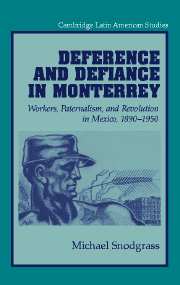Book contents
- Frontmatter
- Contents
- Acknowledgments
- Introduction
- 1 Porfirian Progress in “Mexico's Chicago”
- 2 Revolution Comes to Monterrey
- 3 Work, Gender, and Paternalism at the Cuauhtémoc Brewery
- 4 Making Steel and Forging Men at the Fundidora
- 5 The Democratic Principles of Our Revolution: Labor Movements and Labor Law in the 1920s
- 6 Every Class Has Its Leaders: ASARCO, The Great Depression, and Popular Protest in Monterrey
- 7 Stay with the Company or Go with the Reds
- 8 State Your Position!: Conservatives, Communists, and Cardenismo
- 9 The Quotas of Power: Organized Labor and the Politics of Consensus
- 10 The Persistence of Paternalism
- 11 The Institutionalized Revolution
- Select Bibliography of Primary Sources
- Index
11 - The Institutionalized Revolution
Published online by Cambridge University Press: 19 August 2009
- Frontmatter
- Contents
- Acknowledgments
- Introduction
- 1 Porfirian Progress in “Mexico's Chicago”
- 2 Revolution Comes to Monterrey
- 3 Work, Gender, and Paternalism at the Cuauhtémoc Brewery
- 4 Making Steel and Forging Men at the Fundidora
- 5 The Democratic Principles of Our Revolution: Labor Movements and Labor Law in the 1920s
- 6 Every Class Has Its Leaders: ASARCO, The Great Depression, and Popular Protest in Monterrey
- 7 Stay with the Company or Go with the Reds
- 8 State Your Position!: Conservatives, Communists, and Cardenismo
- 9 The Quotas of Power: Organized Labor and the Politics of Consensus
- 10 The Persistence of Paternalism
- 11 The Institutionalized Revolution
- Select Bibliography of Primary Sources
- Index
Summary
Histories of Mexico's revolution often conclude the story with President Cárdenas's retirement from public life. The year 1940, then, marks a watershed, the moment when so many revolutionary hopes had been fulfilled and the revolutionary project therefore concluded. In the six years following his inauguration, the state sanctioned the unionization of hundreds of thousands of workers. The government distributed millions of acres of land to farm workers and peasant villages. Key industries like the railways and oil had been nationalized by the state. The Cárdenas regime established the foundations for stability by taming the last of the rebellious generals and by fashioning a corporatist political machine that ran on the votes of loyal workers, peasants, and a growing middle class. A party that ruled for the rest of the century safeguarded the reforms that did away with Porfirian Mexico and ushered in a new, postrevolutionary order, the one of political stability and economic growth known as the “Mexican miracle.” So read the “official” history of the revolution, the one fashioned by ruling party ideologues and taught to generations of Mexican schoolchildren. The story endured because much of it rang true.
By the late twentieth century, few events in modern Latin American history had produced greater scholarly output than the Mexican Revolution. Scholars who witnessed the upheaval portrayed it as a “social revolution.”
- Type
- Chapter
- Information
- Deference and Defiance in MonterreyWorkers, Paternalism, and Revolution in Mexico, 1890–1950, pp. 282 - 314Publisher: Cambridge University PressPrint publication year: 2003



